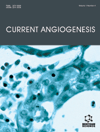- Home
- A-Z Publications
- Current Angiogenesis (Discontinued)
- Previous Issues
- Volume 3, Issue 4, 2014
Current Angiogenesis (Discontinued) - Volume 3, Issue 4, 2014
Volume 3, Issue 4, 2014
-
-
Novel Therapeutic Strategies For Angiogenesis Inhibition In Recurrent Ovarian Cancer
More LessAuthors: Victoria L. Chiou, Elise C. Kohn, Nicole Davarpanah and Jung-Min LeeAngiogenesis plays a vital role in ovarian carcinogenesis and has become an important therapeutic target of ovarian cancer. Insights into the genomic complexity of ovarian cancer and modest single-agent activity of targeted agents have led to testing of biologic agent combinations in order to leverage modulation of potentially interactive targets. Many studies have added angiogenesis inhibitors to chemotherapy in ova Read More
-
-
-
Trebananib (AMG 386): A Non-VEGF Antiangiogenesis Option in Women with Ovarian Cancer
More LessAuthors: Al Wadi Khalid and Ghatage PrafullEpithelial ovarian cancer (EOC) is the most frequent cause of death from all gynecological malignancies with the majority of women being diagnosed with advanced stage disease. It is considered a chemosensitive cancer with a high initial response rate to first-line platinum and taxane-based chemotherapy. However, a majority of patients will relapse with subsequent resistance to treatment and ultimately succumb to th Read More
-
-
-
Anti-angiogenic Therapy and Induction of Blood Vessel Normalization in the Treatment of Ovarian Cancer
More LessAuthors: Simone Ten Kortenaar, Jack Lawler and Jim PetrikAngiogenesis describes the sprouting of new blood vessels from preexisting vascular networks. A tightly regulated balance between pro- and antiangiogenic factors regulates this process, which can be disrupted under pathological conditions. Tumor development is characterized by an “angiogenic switch”, which results in an increase in expression of pro-angiogenic factors such as vascular endothelial growth factor (VE Read More
-
-
-
Ovarian Cancer - Angiogenesis and Targeted Therapy
More LessEpithelial ovarian cancer (EOC) is the leading cause of death from gynecologic malignancies in developed countries. Despite advances in chemotherapy leading to improved outcomes in EOC, mortality rates have marginally decreased, because most patients will develop resistance to standard chemotherapy. New anti-tumor agents with novel mechanisms of action are needed. Angiogenesis is one of the regulated proc Read More
-
-
-
VEGF/VEGFR2 Autocrine Signaling Stimulates Metastasis in Prostate Cancer Cells
More LessVascular endothelial growth factor receptor 2 (VEGFR2) is a tyrosine kinase receptor for the angiogenic growth factor, VEGF. VEGFR2 is typically found in hematopoietic stem cells and endothelial cells. We report the expression of VEGFR2 on highly metastatic human prostate cancer cells. Using real-time RTPCR, immunoprecipitation, western blotting, ELISA, and radioligand crosslinking, we demonstrate the expression and Read More
-
-
-
Quantization of Angiogenesis and Image Analysis
More LessQuantitative Pathology is engaged with the determination of morphological characteristics of tissues. One important field of measurement is the estimation of angiogenesis in malignant neoplasms. The parameters of angiogenesis that are determined include: microvascular density (MVD), total vascular area (TVA) and vessel’s major axis length, minor axis length, area, perimeter, compactness, shape factor and Feret diame Read More
-
Volumes & issues
Most Read This Month
Article
content/journals/cag
Journal
10
5
false
en


